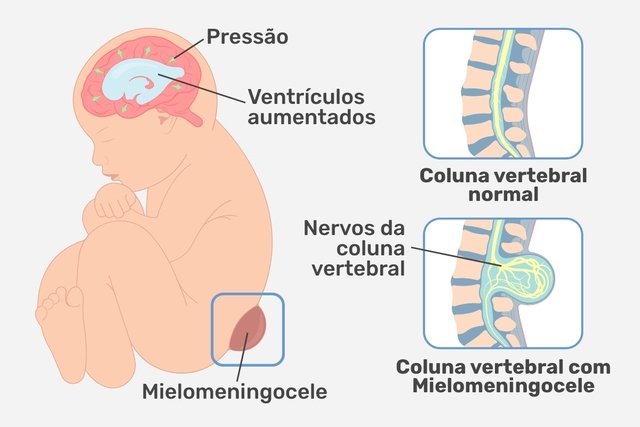Myelomeningocele is the most serious type of spina bifida, in which the bones of the baby’s spine do not develop properly during pregnancy, causing the appearance of a sac on the back that contains the spinal cord, nerves and cerebrospinal fluid.
Generally, the appearance of the myelomeningocele pocket is more common in the lower back, but it can appear anywhere along the spine, causing symptoms in the child such as loss of sensitivity and function of the extremities and problems controlling the sphincters, for example.
There is no cure for myelomeningocele because, although it is possible to reduce the pouch with surgery, the injuries caused by the problem cannot be completely reversed.

Main symptoms
The main symptoms of myelomeningocele are:
- Appearance of a bag on the baby’s back;
- Difficulty or lack of movement in the legs;
- Muscle weakness;
- Loss of sensitivity to heat or cold;
- Urinary and fecal incontinence;
- Malformations in the legs or feet;
- Learning problems;
- Seizures.
In some cases, it is also possible to notice problems in the formation of the brain and excess cerebrospinal fluid, a situation known as hydrocephalus. In some cases, babies with myelomeningocele are born with other medical problems, such as excessive curvature of the spine, hip problems, heart and kidney changes, and/or equinus foot.
How the diagnosis is made
During pregnancy, there are prenatal tests to determine whether the baby has this type of change or other congenital changes, such as:
- Alpha-fetoprotein (AFP) testwhich is a protein produced by the baby during pregnancy and its increased level in the blood may be indicative of myelomeningocele;
- Prenatal ultrasound or fetal MRI;
- Amniocentesisin which the doctor takes a small sample of the amniotic fluid to evaluate its characteristics and amount of AFP.
Despite examinations, in most cases myelomeningocele is diagnosed after birth by observing the bag on the baby’s back. In this case, the doctor may also request imaging tests, such as x-rays, magnetic resonance imaging and computed tomography to evaluate the baby’s spine and spinal bones more clearly.
Make an appointment with the nearest doctor so that a diagnosis can be made and treatment can begin:
Taking care of your health has never been easier!
What causes myelomeningocele
The cause of myelomeningocele is not yet well established, however it is believed to be the result of genetic and environmental factors, and is normally related to a family history of spinal malformations or folic acid deficiency.
Some factors that may increase a woman’s risk of having a child with myelomeningocele are:
- Taking some medications to treat seizures during pregnancy;
- Have had a previous pregnancy with a baby with spina bifida;
- Ter diabetes.
To prevent myelomeningocele, it is important that pregnant women take folic acid supplementation before and during pregnancy, as in addition to preventing myelomeningocele, it prevents premature birth and pre-eclampsia, for example. See how folic acid supplementation should be done during pregnancy.
How the treatment is carried out
The treatment of myelomeningocele is generally started within the first 48 hours after birth with surgery to correct the change in the spine and prevent the emergence of infections or new lesions in the spinal cord, limiting the type of sequelae.
Although treatment for myelomeningocele with surgery is effective in curing the injury to the baby’s spine, it is not capable of treating the sequelae that the baby has had since birth. That is, if the baby was born with paralysis or incontinence, for example, it will not be cured, but it will prevent the emergence of new sequelae that could arise due to exposure of the spinal cord.
How is the surgery done
Surgery to treat myelomeningocele is typically done in hospital under general anesthesia and should ideally be done by a team that includes a neurosurgeon and a plastic surgeon. This is because it generally follows the following step-by-step procedure:
- The spinal cord is closed by the neurosurgeon;
- The back muscles are closed by a plastic surgeon and a neurosurgeon;
- The skin is closed by the plastic surgeon.
Often, as there is little skin available at the site of the myelomeningocele, the surgeon needs to remove a piece of skin from another part of the baby’s back or bottom, to make an excerpt and close the opening in the back.
In addition, most babies with myelomeningocele can also develop hydrocephalus, which is a problem that causes excessive accumulation of fluid inside the skull and, therefore, it may be necessary to have further surgery after the first year of life to place a system that helps drain fluids to other parts of the body. Find out more about how hydrocephalus is treated.
Is it possible to perform surgery on the uterus?
Although it is less common, in some hospitals, there is also the option of performing surgery to terminate the myelomeningocele before the end of pregnancy, while still inside the pregnant woman’s uterus.
This surgery can be performed at around 24 weeks, but it is a very delicate procedure that should only be carried out by a well-trained surgeon, which ends up making the surgery more expensive. However, the results of in-utero surgery appear to be better, as there is less possibility of new spinal cord injuries during pregnancy.
Physiotherapy for myelomeningocele
Physiotherapy for myelomeningocele should be done during the baby’s growth and development process to maintain joint range and prevent muscle atrophy.
Furthermore, physiotherapy is also a great way to encourage children to deal with their limitations, as in the case of paralysis, allowing them to lead an independent life, through the use of crutches or a wheelchair, for example.
When to go back to the doctor
After the baby is discharged from the hospital, it is important to go to the doctor when symptoms such as:
- Fever above 38ºC;
- Lack of desire to play and apathy;
- Redness at the surgery site;
- Decreased strength in unaffected limbs;
- Frequent vomiting;
- Dilated mole.
These symptoms may indicate serious complications, such as infection or hydrocephalus, which is why it is important to go to the emergency room as quickly as possible.

Sign up for our newsletter and stay up to date with exclusive news
that can transform your routine!
Warning: Undefined array key "title" in /home/storelat/public_html/wp-content/plugins/link-whisper-premium/templates/frontend/related-posts.php on line 12
Warning: Undefined array key "title_tag" in /home/storelat/public_html/wp-content/plugins/link-whisper-premium/templates/frontend/related-posts.php on line 13




